This is the first part of two posts analyzing Virginia’s 2009 gubernatorial election. The second part can be found here.
A normal observer might see the above map and naturally conclude that the Democratic candidate lost a landslide election. This is not always the case. In the 1968 presidential election, for instance, the state of New York looked like this:
Although it does not look like it, Democratic candidate Hubert Humphrey won the state: 49.76% to 44.30%.
More below.
In November 2009, however, State Senator Creigh Deeds did in fact receive a thorough pummeling from Attorney General Bob McDonnell. An unappealing candidate running in a tough national climate, Mr. Deeds lost the race 41.25% to 58.61%.
Creigh Deeds only won two types of counties: his home district and Democratic strongholds. The former include the two blue counties along the state’s eastern border. The latter are populated by two Democratic constituencies: firstly, blacks in Virginia’s 3rd congressional district and secondly, wealthy suburbanites south of Washington (Virginia’s 8th congressional district).
Surprisingly (and disturbingly) Mr. Deeds lost Fairfax County, the key to recent Democratic success in Virginia. Rich, diverse, and heavily populated – Northern Virginia suburban voters were largely responsible for Democratic victories by Governor Tim Kaine, Senator Jim Webb and President Barack Obama.
Mr. McDonnell’s victory in Fairfax indicates one of two things. Either the Democratic Party has not entrenched itself in NoVa – or it is moving back to the Republicans. The latter possibility is highly worrisome and not simply confined to Virginia.
There is little more that the above map indicates – one cannot tell much from a map that just shows red counties. Differentiating the mass of red reveals more:
This image maps the results based on degree of support. It shows a substantial east-west divide hidden in the first map. Western Virginia voted Republican with far more intensity; eastern Virginia tended to be more moderate in its support of Mr. McDonnell.
Notice how intensely Republican the western panhandle is voting. These voters – poor, white, rural Appalachian folk – used to vote Democratic based on economic appeals. This trend subsisted even in fairly recent times: John Kerry won a couple counties; Senator Jim Webb took three. Former president Bill Clinton did even better (he lost the state by 1.96%):
Creigh Deeds, a moderate politician representing an Appalachian district, was supposed to appeal to the rural voters populating western Virginia; as the map makes evident, he failed to do so (outside his home districts). I suspect Barack Obama may have something to do with this; his poor performance amongst Appalachian voters may be affecting Democratic candidates everywhere. Given the many Democratic politicians elected from Appalachia, this – if true – would definitely be a bad thing.
Finally, it is possible to map the results if Mr. Deeds had tied Mr. McDonnell:
This indicates the relative Democratic or Republican lean of each county – a county may vote Republican but still lean Democratic compared to the overall result, and vice versa. Massachusetts, for example, voted Republican in Ronald Reagan’s 1984 landslide – but nobody would accuse it of being a Republican state. It went red, but relative to the rest of the nation was more Democratic.
The next section will compare this map with similar images derived from previous Democratic coalitions.
(Note: All statistics are derived from http://www.uselectionatlas.org/ ).
–Inoljt, http://mypolitikal.com/
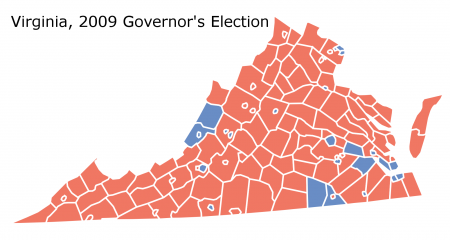
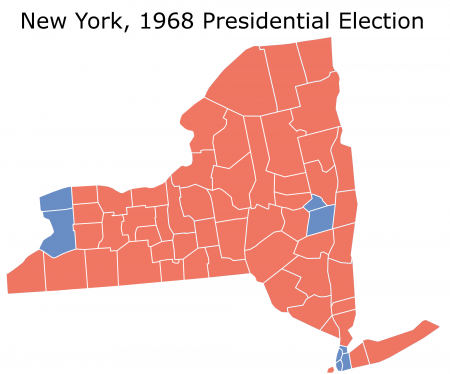
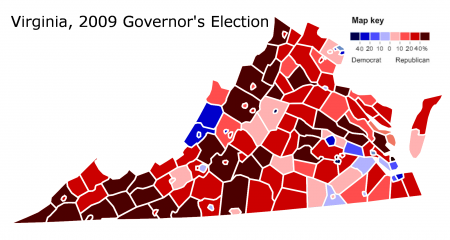
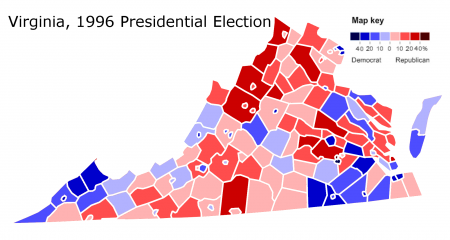
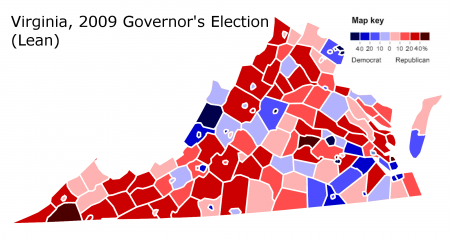
6 comments